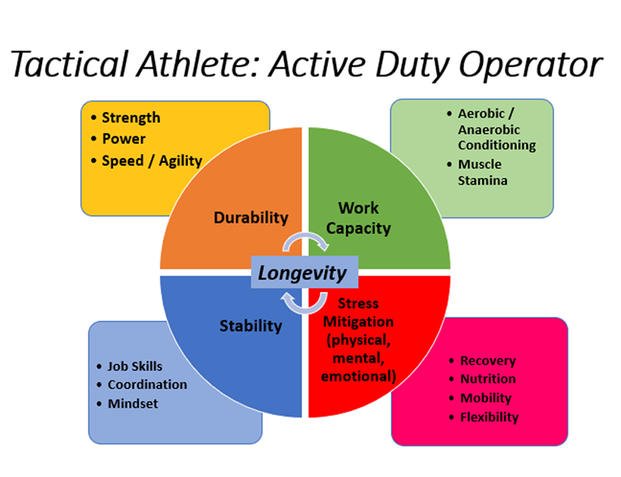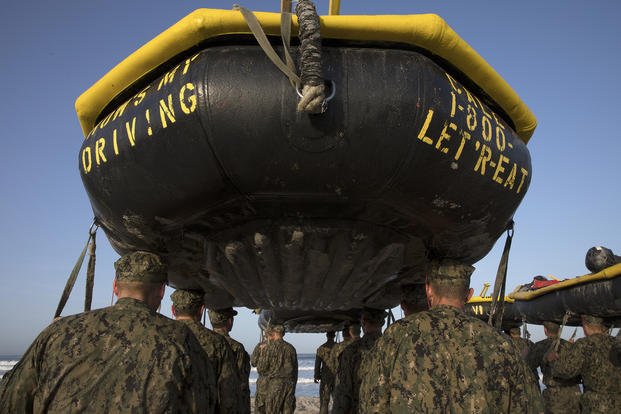The most asked question from future BUD/S candidates is: "Should I gain weight or lose weight prior to BUD/S?" The more complete version of that question is: "For each of the average heights that join the Navy, what is the recommended weight to be able to endure BUD/S?"
Being durable typically requires some strength with muscle mass. Having the work capacity for long days of activities requires cardio conditioning and muscle stamina that lends to a leaner body type. People of all shapes and sizes make it through and do not make it through BUD/S.
The average-sized person is both the person most likely to graduate and the person most likely not to get dropped. Do not get too tied up into your height and weight, because it is just one factor of a person's chances of success or failure.
The following charts are the Navy height and weight standards as well as my recommendations from years of observations. Another interesting data point is the height/weight in the Success in Hell Week study completed by BUD/S. As with any data, however, there will be outliers on both ends of the spectrum as well as a plus and minus 10 pounds per inch range.
You will notice that the maximum height and weight for the regular Navy is not a bad zone to be in when your future is a highly advanced tactical fitness selection. Being good at all the elements of fitness is a requirement when many tasks are long miles of running, swimming, rucking and many repetitions of calisthenics, and heavy lifts and carrying activities of boats and logs. Being cold and wet also typically requires some extra body weight so you do not become hypothermic too easily. Yet the high mileage and challenging long hours of work requires a cardiovascular conditioning that typically will create a leaner body type.

There are, of course, BUD/S students who are taller and shorter than the chart range below. And there are also outliers who are freaks of nature who are 230 pounds and still can crush the physical screening test (PST), run 24-25 minutes for four miles and do 30 pull-ups. Yet others are very light at 140 pounds or less and crush the runs, PTs, obstacle course and made it through training without getting crushed by logs and boats.
The average heavier guy (220-plus) will have a difficult time with pull-ups, running and obstacle courses. The lighter guy (under 140 lbs.) will have a tougher time under the boats and logs. Taller people will have issues with the boats as well, especially if they are the tallest in the boat crew.
Typically, however, most students are in the average-sized man zone of 68-70 inches and 170-190 pounds. This is tall enough and enough muscle mass typically to do well at BUD/S. Being taller and thinner with enough strength to handle the load-bearing activity and enough cardio endurance to handle the runs, swims and rucks tends to be a body type for success.
On the other side of the spectrum, heavier with strength to handle the load bearing and still fast enough in cardio endurance to handle the runs, swims and rucks tend to be more of a body type for the shorter students.
| Height / Weight Ranges Suited for Selection Programs | ||
| Height (inches) | Navy Max Weight Standard (lbs) | BUD/S Weight Range (lbs) |
| 65 | 165 | 160-170 |
| 66 | 170 | 165-175 |
| 67 | 175 | 170-180 |
| 68 | 181 | 175-180 |
| 69 | 186 | 175-180 |
| 70 | 191 | 175-185 |
| 71 | 196 | 180-190 |
| 72 | 201 | 185-200 |
| 73 | 206 | 190-205 |
| 74 | 211 | 205-215 |
| 75 | 216 | 215-220 |
| 76 | 221 | 215-225 |
The height/weight standards in the Navy are also dependent on body fat. Many people who have significant muscle often will be out of the height and weight standards. However, when they measure body fat, as long as they are under the body-fat percentage for their age, they are good to go. For instance, I was 72 inches and 205 pounds for a significant time while in the Navy. I was able to pass since I had about a 10% body fat. When I was at BUD/S, I was 72 inches and 195 lbs.
If you were to plot the height and weights of classes of BUD/S graduates, you will see a diverse grouping with some on the lighter end of this chart and some on the heavier end and beyond. The overall effect is more of a bell curve, with a majority in the middle grouping of 68-72 inches tall with a body weight in the 175- to 195-pound range.
There obviously will be shorter, lighter, taller and heavier in every class, but these are the recommended weights for any height; you need the extra mass for strength (logs, boats, ruck) and warmth in the cold Pacific waters.
In the end, it really does not matter what size you are, as it truly matters what the size of your heart is and how committed you are to graduating. You have to get good at all the elements of fitness, regardless of your height. How do you get good at all the elements of fitness -- periodization -- in this case, a tactical fitness version of periodization. Periodization Discussion Video.
Stew Smith is a former Navy SEAL and fitness author certified as a Strength and Conditioning Specialist (CSCS) with the National Strength and Conditioning Association. Visit his Fitness eBook store if you’re looking to start a workout program to create a healthy lifestyle. Send your fitness questions to stew@stewsmith.com.
Want to Learn More About Military Life?
Whether you're thinking of joining the military, looking for fitness and basic training tips, or keeping up with military life and benefits, Military.com has you covered. Subscribe to Military.com to have military news, updates and resources delivered directly to your inbox.
















